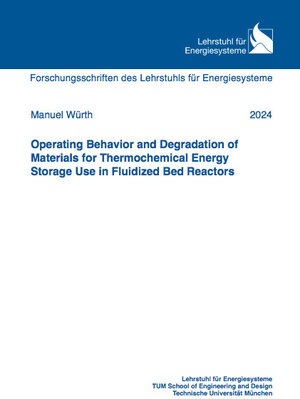
×
![Buchcover ISBN 9783843955317]()
Operating Behavior and Degradation of Materials for Thermochemical Energy Storage Use in Fluidized Bed Reactors
von Manuel WürthThe European and German industrial sectors heavily rely on natural gas for process heat generation, creating a need for alternative solutions in line with climate goals. Electrification combined with renewable energy, particularly Power-to-Heat technologies, offers a viable path forward. In this context, Thermochemical Energy Storage (TCES) using calcium oxide (CaO) and calcium hydroxide (Ca(OH)2) is a promising hybrid solution for industrial process heat and storage. This dissertation explores a fluidized bed design for scaling up TCES systems and addresses the degradation and attrition of storage materials during cycling.
An experimental approach was used with three fluidized bed setups to study non-reactive and reactive conditions. Tests show that non-reactive attrition has a minor impact but increases with pre-stress and fluidization velocity. Material cycling with the same batch of material for 40.5 cycles led to significant reductions in bulk density and particle size. Though attrition is inevitable, optimizing pre-treatment conditions and reducing ambient carbonation appear to help mitigate degradation effects.
Furthermore, a make-up material exchange strategy was developed to enable cycling beyond 50.5 cycles, stabilizing material properties and ensuring continuous operation. Findings also include insights into onset temperatures for reactions and fluidization challenges, providing a foundation for designing a pilot-scale reactor while addressing process stability, material handling, and operational limits for industrial application.
An experimental approach was used with three fluidized bed setups to study non-reactive and reactive conditions. Tests show that non-reactive attrition has a minor impact but increases with pre-stress and fluidization velocity. Material cycling with the same batch of material for 40.5 cycles led to significant reductions in bulk density and particle size. Though attrition is inevitable, optimizing pre-treatment conditions and reducing ambient carbonation appear to help mitigate degradation effects.
Furthermore, a make-up material exchange strategy was developed to enable cycling beyond 50.5 cycles, stabilizing material properties and ensuring continuous operation. Findings also include insights into onset temperatures for reactions and fluidization challenges, providing a foundation for designing a pilot-scale reactor while addressing process stability, material handling, and operational limits for industrial application.


